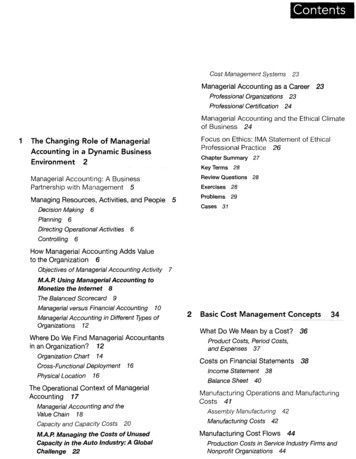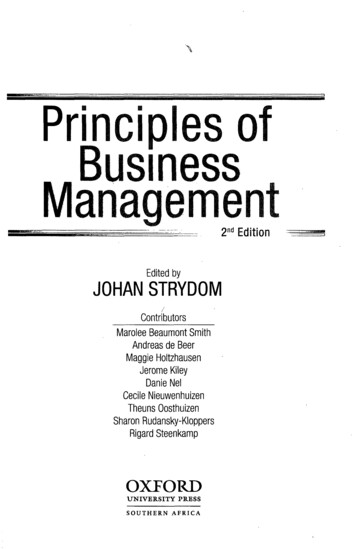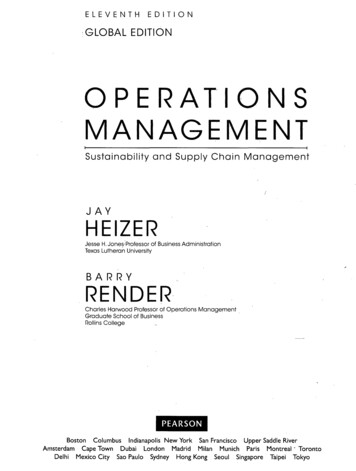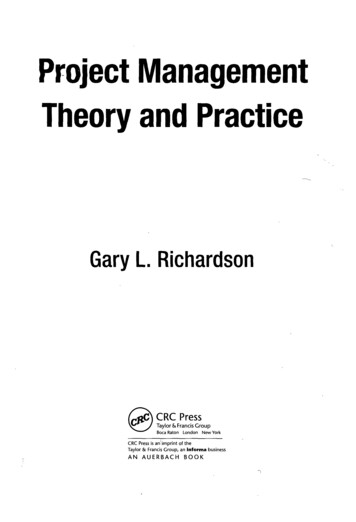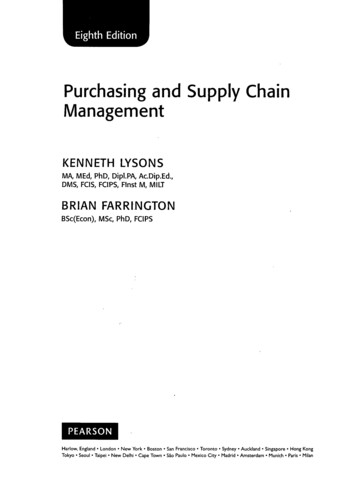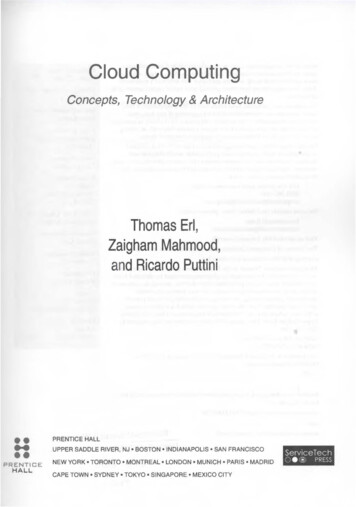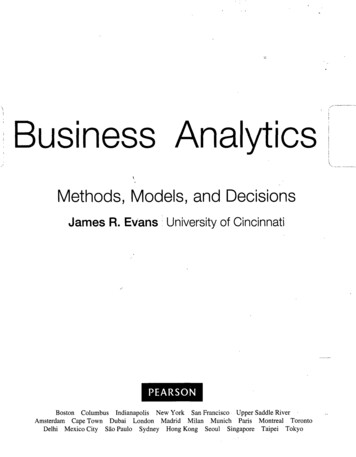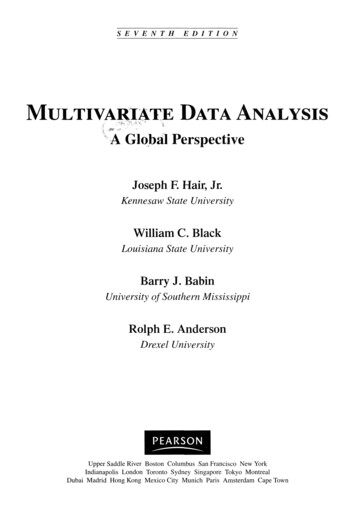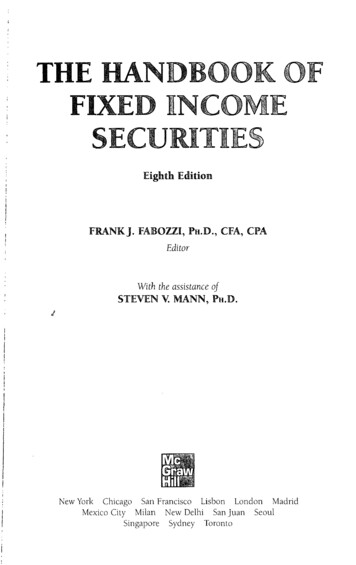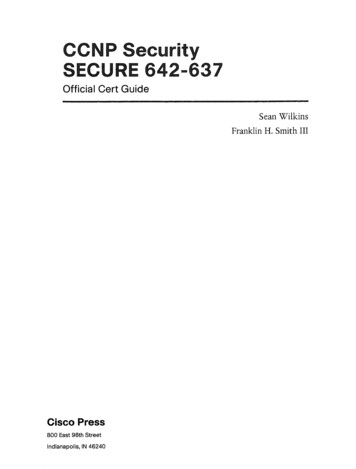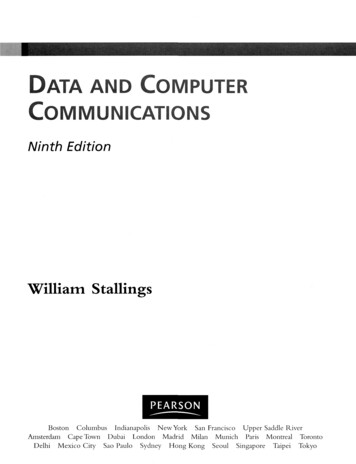
Transcription
Management TodayBest Practices for theModern WorkplaceTerri A. ScanduraUniversity of MiamiKim GowerUniversity of Mary Washington SAGE
DETAILED CONTENTSPrefacexxiAcknowledgmentsxxviiAbout the AuthorsxxixPART I: INTRODUCTIONChapter 1: Becoming a Manager2What Managers Do3What Is Management?5The Management ProcessPlanning66OrganizingLeading66ControllingA Brief History of Management TheoryEarly Management TheoriesTheory X and Theory YBehavioral Aspects of ManagementThe Learning OrganizationEthicsDisruptive ChangeSustainabilityManagerial Roles7779101113141516Interpersonal RolesInformational Roles1617Decisional Roles17Managerial Behaviors Careers in Management: What Does a Restaurant Manager Do?1819Skills Managers Need Today20Evidence-Based ManagementC Fact or Fiction?: Is a Happy Worker a Productive Worker?Critical ThinkingAnalytics21222325Plan For This Textbook26Managerial Implications27Key Terms28Toolkit28
Activity 1.1 Learning About Managerial Roles28Activity 1.2 What Does It Mean to Be Successful?29Case Study 1.1 Facebook.com: The Cambridge Analytics Scandal30Self-Assessment 1.1 Are You Theory X or Theory Y?31PART II: PLANNINGChapter 2: Making Decisions and Using Analytics34Decisions: The Big Ones35Decision-Making in Organizations37The Rational Decision-Making Process37Limits to Rational Decision-Making39Bounded Rationality39Prospect Theory39Framing40Intuition41Benefits of Intuition42Heuristics43Decision Traps44Hindsight Bias44Overconfidence45Escalation of Commitment45Avoiding Derailment Through Planning47Creative Problem-SolvingThree-Component Model of CreativityMaking Decisions Using Business AnalyticsManagement Analytics48484950 Fact or Fiction?: Do Companies Know Your Secrets?51 Careers in Management: Careers in Business Analytics53Overcoming the Fear of Data and StatisticsThe Era of “Big Data”Examples of Big-Data Analytics545455Managerial Implications56Key Terms57Toolkit57Activity 2.1 Exxel’s New Product Development Decision57Case Study 2.1 A New Mission Statement for the MBCCorporation58Case Study 2.2 “Effective . but Creepy” Employee Tracking andData Collection59Self-Assessment 2.1 What Is Your Attitude Toward Risk?61Self-Assessment 2.2 Are You Afraid of Statistics?62
ç iStockphoto.Chapter 3: Ethics and Social ResponsibilityWhat Role Do Ethics and Social Responsibility Play inEffective Management?What Do People Think of When They Think of Ethics?The Social World Is Messy and Ethics Help Us Navigate ItKohlberg’s Stages of Moral Development6869717173Level 1 : Pre-Conventional Level73Level 2: Conventional Level74Level 3: Post-Conventional or Principled Level74Criticisms of Kohlberg’s Theory of Moral Development75Ethical ClimateFive Types of Ethical ClimatesEthical LeadershipC Fact or Fiction?: Misconceptions About Ethical LeadershipEthical Decision-MakingThe PLUS Decision-Making Model767677788081Ethics Filters82Moral Intensity83The Importance of Corporate Social ResponsibilityA Change in PerspectiveThe Future of Corporate Social Responsibility838486O Careers in Management: Corporate Social Responsibility(CSR) Director87Where Do We Draw the Line in Employee Technology Privacy?89Managerial Implications89Key Terms90Toolkit91Activity 3.1 Trolley Problem: Ethical Decision-Making Exercise91Case Study 3.1 The College Admissions Scandal92Case Study 3.2 Real Life Choices in Corporate SocialResponsibility93Self-Assessment 3.1 Moral Courage94Chapter 4: Organizational Culture and Change96A Small Business Implements Change97Organizational Culture and Its Characteristics98Levels of Organizational Culture99How Managers Shape Organizational Culture101
Strong Organizational CulturesThe Perfect CultureG Fact or Fiction?: Zappos Part II: Do We Need ticipatory Socialization105Organizational Entry and Assimilation106Metamorphosis107How Employees Learn 9Forces Driving Organizational Change110Types of Organizational Change111Organizational Subsystems Involved in Planned Change112Why Organizational Change Efforts Fail112Resistance to Change113 Careers in Management: Organizational Development (OD)Overcoming Resistance to ChangeLewin’s Three-Step ModelPractical Steps for Applying the Three-Step Model114115116117Force-Field Analysis118The Change Curve119Nine Tips for Managing Organizational ChangeManagerial ImplicationsKey TermsToolkit121123124124Activity 4.1 Comparing Organizational Culturesin the Gaming Industry124Activity 4.2 Understanding Organizational Culture125Case Study 4.1 How It All Went Wrong at JCPenney125Self-Assessment 4.1 Organizational Readiness forImplementing Change (ORIC)127Chapter 5: Strategic Management and Planning130How Important Is Strategic Management?131Strategic Plans132Mission and Vision Statements134 How Google Built an Effective Vision and Mission Statement1350 Fact or Fiction?: Real Mission Statement Wins and Kefuffles136
Competitive AdvantageIdentifying Values in Six Steps138139Porter’s Five Forces and SWOT AnalysisUsing Porter’s Five Forces for AnalysisSWOT AnalysisConducting a SWOT AnalysisComparing Five Forces and SWOTGoals and ObjectivesObjectivesManagement by Objectives (MBO)Long-Term Objective FormulationO Careers in Management: Knowledge Management ProfessionalFeedback LoopModern Strategic-Planning Not-for-Profit Strategic Planning150Wicked Strategic Management151Big-Data Strategic Management151Emergent Strategy151Blue-Ocean Strategic Planning152Understanding Profit and the 3Ps in Strategic Planning153Managerial Implications155Key Terms155Toolkit156Activity 5.1 SWOT Yourself156Activity 5.2 How Much Do Your Core Values Matterto the Organization?156Case Study 5.1 Did Transgenerational ResponseCause Yahoo to Fail?158Self-Assessment 5.1 Time Perspectives and Strategic PlanninghapterS: Organizational Design160164Structure: Who Needs It?165Millennial and Gen Z Appeal165What Is Organizational Structure?167Dimensions of Organizational Design170Forms of Organizational Structure171Entrepreneurial OrganizationMachine OrganizationProfessional Organization172173174
Divisional (Diversified) Organization174Innovative Organization (“Adhocracy”)174Organizational Structure Types175Functional Organization175Product Organization176Geographic Organization178Matrix Organization179Virtual Organization1800 Careers in Management: Organizational Design Consultant181Levels of Management182Sociotechnical System and Job Design184Job Characteristics185Job Redesign186Job-Crafting186O Fact or Fiction?: Mean Companies? Lazy Employees?Why Telecommuting Is Off to a Rough Start187Managerial Implications188Key Terms189Toolkit190Activity 6.1 Organization Chart190Activity 6.2 Applying the Job Characteristics Model190Case Study 6.1 Will Flat Management Fall Flat?191Self-Assessment 6.1 How Much Structure Do You Need?192Chapter 7: Communication194Oprah Winfrey’s Conversational Competence195What Is Communication?197Communication Apprehension197One-Way Versus Two-Way Communication197The Communication Process198The Importance of Feedback in the Communication Process198Example of the Shannon-Weaver Model199Language Barriers to Effective Communication200Jargon200Trigger Words200Improving Organizational Communication201Training201Active Listening202Communication Challenges203The Impact of Technology on Communication203Electronic Communication204Nonverbal Communication206
Cross-Cultural CommunicationG Fact or Fiction?: Does Nonverbal Communication Have theSame Meaning Everywhere?Managing Knowledge in OrganizationsDownward Communication207210211212Upward Communication212Horizontal Communication213External Communication214Communication NetworksO Careers in Management: Public Relations SpecialistKnowledge Transfer Within Organizations214215216Managerial Implications217Key Terms218Toolkit219Activity 7.1 One-Way Communication219Activity 7.2 Giving and Receiving Effective Feedback219Case Study 7.1 “Ask Dharmesh Anything” at HubSpot220Self-Assessment 7.1 Communication Apprehension222Self-Assessment 7.2 What Communication Style Are You?224Chapter 8: Human Resource Systems228Will You Be Hired by a Chatbot?229What Is Human Resource Management?231HRM in OrganizationsHRM Versus “Management” Careers in Management: Human Resources SpecialistHuman Resources and Human CapitalC Fact or Fiction?: Myths About Human Resource Management231232233234235Outsourcing the HR Function236HRM: What’s in a Name?236The Functions of HRM236Staffing237Compensation239The Relationship of Performance Management to Compensation240Sources of Performance Management Ratings240Performance Management Methods241Challenges in Performance Management242What About the Money?244Other Forms of Compensation245
Training and Development245Steps in the Training Process246Transfer of Training249The “New Finish Line”249Cross-Cultural Training251Strategie Human Resource ManagementMichigan: “Hard Strategie HRM”Harvard: “Soft Strategie HRM”251252252Managerial Implications254Key Terms255Toolkit255Activity 8.1 Getting Past the Al Résumé Screening255Activity 8.2 Whom to Promote?256Activity 8.3 Design a Communication Training Activity257Case Study 8.1 Wearables and Employee Privacy258Self-Assessment 8.1 Situational Judgment Test259PART IV: LEADINGChapter 9: Understanding Individuals and Diversity264What Would You Do?265What Is Personality?267Heredity Influences Personality267Myers-Briggs Type Indicator268Limitations of the MBTI268Applications of the MBTI in Organizations269The Big Five269Personality Traits and Your Health270O Fact or Fiction?: Should I Get a Trophy for Trying?271Psychological Capital272Emotional Intelligence273Can Emotional Intelligence Be Learned?273Limitations of Emotional Intelligence274What We Know About El274Diversity ApproachesSurface-Level and Deep-Level Diversity274275Discrimination and Fairness275Challenges to Affirmative Action276Learning277
J—'7TTT z ./A' z z.z ' 4./Z / z t f J. . Z7y i. J 7 7/ ?z. ./ ' '.-‘Z-z'./// /'z ‘ iStockphoto xxmi/plwtoicchnoEffectiveness278Women and Men at Work279Generations in the Workplace280The Millennials281And . . . Here Gomes Generation Z!282Limitations of Generational Differences283Managing Diverse FollowersDiversity Mission Statements0 Careers in Management: Chief Diversity OfficerPromoting Open Discussions About Diversity284284285286Managerial Implications287Key Terms288Toolkit288Activity 9.1 Emotional Intelligence Exercise288Activity 9.2 Experiences of Diverse Managers289Case Study 9.1 Covering Up Diversity289Self-Assessment 9.1 Big-Five Personality Test290Self-Assessment 9.2 Type A or Type B Behavior Pattern291Self-Assessment 9.3 Attitudes Toward Diversity Scale293Chapter 10: Motivation296Can You Solve the Candle Problem?297What Is Motivation?299Relationship Between Motivation and Performance300Intrinsic and Extrinsic Rewards300Need Theories301Maslow’s Hierarchy of Needs301McClelland’s Need Theory302Alderfer’s ERG Theory303Herzberg’s Two-Factor Theory304Expectancy Theory Careers in Management: Understanding EntrepreneurialMotivation Using Expectancy TheoryGoal Setting306307308Limitations of Goal Setting309How to Give Effective Feedback311Reinforcement Theory311Reinforcers312Punishment312Schedules of Reinforcement312
A iStockphoto.com/Cecilie ArcursC Fact or Fiction?: Are There Benefits to Playing Video Games?314Organizational Behavior Modification315Ethical Concerns in OB Mod316Organizational Justice317Equity Theory317Organizational Justice318Managerial Implications318Key Terms319Toolkit320Activity 10.1 What Do Workers Want From Their Jobs?Activity 10.2 Work Values ChecklistCase Study 10.1 KPMG: Motivating Employees With a DeeperSense of PurposeSelf-Assessment 10.1 Maslow’s Hierarchy of NeedsChapter 11: Managing TeamsWhen Teamwork Isn’t Fair320320321323326327Students You Meet in Team Projects327The Invisible Student327The Silent Student327The Procrastinator327The Control Freak328The Teammate Who Overpromises and Underdelivers328What is a Team?329Group Versus Team329Types of Teams330Team GoalsThe Team CharterTeam Development331332333Five-Stage Model333Punctuated Equilibrium Mode!333Team Performance Curve334Team Effectiveness336Team Attitudes: Affect and Viability336Team Behaviors: Creativity and Learning336Team Performance337How to Build Effective Tèams338O Fact or Fiction?: Forget What You Learned in Grade School:Five Teamwork Myths339
iw;.fkkka;kv'k''BV Egg1à—Bi 'S//// T / ; fWiOÄgkkkk-kk/kk- -, kk:,'ivlfiiiii 't: :; k- . - rt/KskxkKe. »»i Ï. ! k-:k'/kk/';;/;; w #:5kk-k feî'-v- ; ; V/ /:.:-k/:-'k k;:k: iStockphoto.com/EonercnTeam ChallengesGroupthink340340Virtual Teams343Multicultural Teams344Team Conflict345Ethical Concerns From Peer Pressure346Five Dysfunctions of a TeamO Careers in Management: Team CoachTeam Decision-Making346347348Devil’s Advocacy348Dialectical Inquiry348Robert’s Rules of Nominal Group Technique352Stepladder353Delphi Method353Managerial Implications354Key Terms355Toolkit355Activity 11.1 The Team Charter355Activity 11.2 Team Decision-Making by Consensus:Hurricane Survival356Case Study 11.1 For Companies, Virtual TeamsShrink the Map358Self-Assessment 11.1 Effective Team RoleBehaviors359Self-Assessment 11.2 Team Conflict361Chapter 12: Leadership364What Makes an Effective Leader?365What Is Leadership?366C Fact or Fiction?; Seven Myths About LeadershipManagers Versus LeadersLeadership TraitsThe Dark TriadLeadership BehaviorsThe Managerial GridIt All Depends—Contingency LeadershipPath-Goal TheoryO Careers in Management: Top “Soft Skills” Employers Look For367367369372374375376376378
The Role of RelationshipsLeader-Member Exchange378379Trust380Transformational Leadership383Transactional Leadership383The Four Ts”384Contemporary Approaches to LeadershipEthical Leadership384385Servant Leadership385Authentic Leadership386Managerial Implications387Key Terms388Toolkit388Activit
Nine Tips for Managing Organizational Change 121 Managerial Implications 123 Key Terms 124 Toolkit 124 Activity 4.1 Comparing Organizational Cultures in the Gaming Industry 124 Activity 4.2 Understanding Organizational Culture 125 Case Study 4.1 How It All Went Wrong at JCPenney 125 Self-Assessment 4.1 Organizational Readiness for
